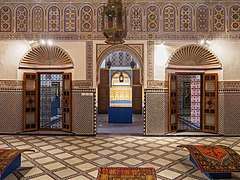Dar Si Said
Dar Si Said (Arabic: دار السي سعيد) is a historic late 19th-century palace and present-day museum in Marrakesh, Morocco. It was built between 1894 and 1900 by Si Sa'id, a vizier and the brother of Ba Ahmad ibn Musa, the Grand Vizier and effective ruler of Morocco during the same period under Sultan Abdelaziz (ruled 1894–1908).[1][2] The palace was turned into a museum in 1932, and has been restored several times since.[3]
.jpg)
Architecture
The palace's architecture is similar in ornament to the Bahia Palace built further south by his father and his brother, but unlike the latter it is built over more than one level and has very different layout. Its architectural highlights include a grand reception hall on the upper floor and a large riad garden with a central pavilion of painted wood.[4][2][1]
Museum collection
The museum collections includes a wide variety of objects, many of them from the southern regions of Morocco.[5] Until recently the museum's exhibits focused on Moroccan wooden art and objects.[5] Its current exhibits now focus on weaving and Moroccan carpets.[4]
Among the most significant objects of the general collection is an elaborately carved marble basin from the Caliphate era of Cordoba. It was crafted at Madinat al-Zahra between 1002 and 1007 to serve as ablutions basin and was dedicated to 'Abd al-Malik, the son of al-Mansur, and was previously kept at the Ben Youssef Madrasa for centuries.[6][7][8]
Gallery
- The riad garden
.jpg) Painted decoration inside the wooden pavilion of the garden
Painted decoration inside the wooden pavilion of the garden A courtyard with fountain in the palace
A courtyard with fountain in the palace One of the grand halls in the palace
One of the grand halls in the palace Cupola over the grand hall
Cupola over the grand hall Rooms of the palace with exhibit on Moroccan carpets
Rooms of the palace with exhibit on Moroccan carpets
See also
- Marrakech Museum
- Bahia Palace
- Nejjarine Museum (in Fes)
References
| Wikimedia Commons has media related to Dar Si Said Museum. |
- Wilbaux, Quentin (2001). La médina de Marrakech: Formation des espaces urbains d'une ancienne capitale du Maroc. Paris: L'Harmattan. p. 289. ISBN 2747523888.
- Deverdun, Gaston (1959). Marrakech: Des origines à 1912. Rabat: Éditions Techniques Nord-Africaines. p. 546.
- Marrakech, Travelguide (2018-01-12). "The Museum Dar Si Said". Travelguide Marrakech. Retrieved 2020-06-04.
- "Dar Si Said | Marrakesh, Morocco Attractions". Lonely Planet. Retrieved 2020-06-04.
- "Dar Si Said (Marrakech, Morocco)". Discover Islamic Art - Virtual Museum. Retrieved 2020-06-05.
- Dodds, Jerrilynn D., ed. (1992). "255". Al-Andalus: The Art of Islamic Spain. New York: The Metropolitan Museum of Art. ISBN 0870996371.
- El Khatib-Boujibar, Naima. "Ablutions basin". Discover Islamic Art, Museum With No Frontiers. Retrieved June 5, 2020.
- Discover Islamic Art in the Mediterranean. Arab Institute for Research and Publishing. 2007. p. 86.